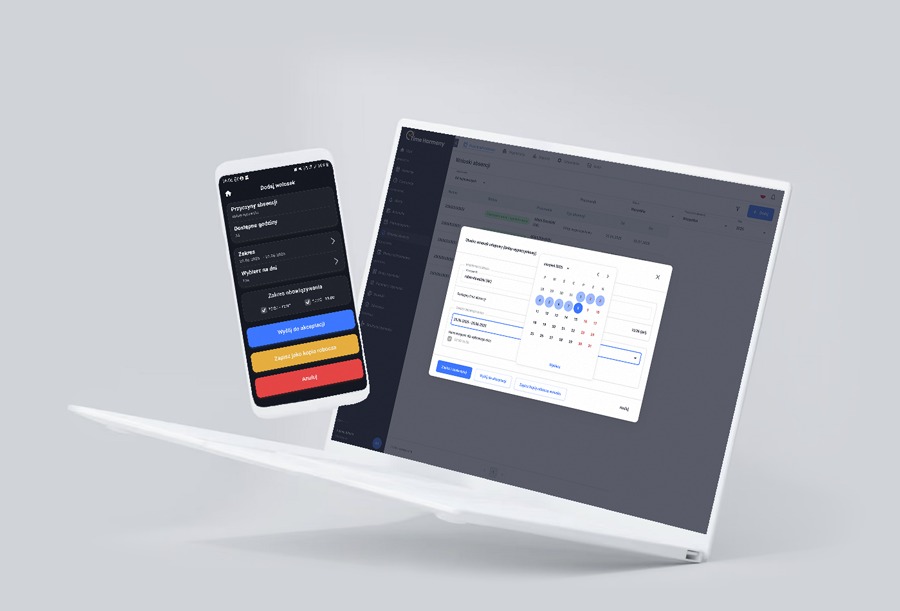Modern organizations are increasingly reaching for flexible models of working time organization. One of them is an equivalent working time system, which, if used correctly, allows you to adjust the working time schedule to the specifics of your business, seasonality or changing staffing needs. In practice, however, it can be difficult to manage, especially in larger companies or environments with diverse schedules.
Time Harmony comes to the rescue – an advanced system for planning, recording and settling working time, which supports employers in the full, legally compliant implementation of an equivalent system.
What is an equivalent working time system?
The introduction of an equivalent working time system may be introduced if it is justified by the type of work or its organization in the workplace. In order to introduce an equivalent working time system, this issue must be regulated in a collective agreement, work regulations or a notice if the workplace is not covered by a collective agreement.
An equivalent working time system requires:
- planning the schedule for at least one month and communicating it to employees at least 7 days before its validity
- ensuring minimum daily (11 hours) and weekly (35 hours) rests,
- correct settlement of overtime,
- compliance with the rules resulting from settlement periods (e.g. 1 month, 3 months, in special cases up to 12 months).
Examples of industries and companies in which the equivalent working time system works:
- Health care – hospitals, ambulance services (on-call duty, shift work).
- Transport and logistics – drivers, warehouse operators.
- Industrial production – especially with production lines operating in continuous motion.
- Hotels and gastronomy – work on weekends and holidays, seasonality.
- Protection of people and property – shift work, the need for constant presence.
- Retail and shopping centres – extended opening hours, increased traffic on selected days of the week.
Agriculture and forestry – dependence on weather conditions and seasonality
Equivalent working time system - limitations
An equivalent working time system cannot be applied to all employees. In accordance with the provisions of the Labour Code, it cannot be used for pregnant and juvenile employees due to special protection of their health and safety. In addition, disabled employees generally cannot work an extended daily working time, unless a doctor agrees to it in a medical certificate.
The equivalent working time system may also not be applied to employees caring for a child until the child reaches the age of 4 if they do not consent to it (Article 178 § 2 of the Labour Code). This protection applies to both mothers and fathers or other legal guardians, regardless of the type of contract or working time. The employer is obliged to respect their will, and the lack of consent to work in the system with an extended daily working time cannot be the basis for any negative consequences on the part of the employer. In practice, this means that these employees cannot be scheduled to work, for example, 10 or 12 hours a day, if they do not agree to it themselves.
Main challenges in working time management in an equivalent system
The implementation of an equivalent system is often associated with many organizational difficulties. The most common problems are:
- errors in scheduling of schedules, leading to violations of regulations,
- lack of tools to control rest periods – which may result in unauthorized employee claims,
- difficulties in settling overtime, especially when changing the work schedule or substitutions,
- inconsistent records of working time, which is important in the case of PIP inspections or labour disputes.
Manual scheduling or recording in Excel increases the risk of errors and burdens the HR department with an excess of operational tasks. This is where the role of modern T&A systems, such as Time Harmony, comes into play.
How does Time Harmony support companies in using the equivalent system?
Time Harmony is a system designed to be fully compliant with the Labor Code and the needs of HR departments, line managers and executives. Its functionalities significantly facilitate the organization of work in an equivalent system.
-
Automated Regulatory Scheduling
The system allows you to create schedules taking into account:
- maximum permissible shift lengths,
- daily and weekly rests,
- work cycles and days off,
- public holidays.
All of this is done automatically — Time Harmony immediately flags conflicts with regulations before they are violated.
-
Correct settlement of overtime
The system distinguishes between daily and average weekly overtime, automatically recording them and assigning them to the appropriate settlement periods. This makes it easier to determine:
- the number of paid overtime,
- time off for overtime,
- allowances in accordance with Article 151(1) of the Labour Code.
Thanks to this, the HR and payroll department does not have to manually analyze and settle each case.
-
Rest monitoring
Time Harmony analyzes every planned and implemented change in terms of ensuring rest:
- 11-hour daily (Article 132 of the Labour Code),
- 35-hour weekly (Article 133 of the Labour Code).
In the event of a breach – the system generates alerts that allow for immediate correction of the schedule.
-
Ready-made reports and legally compliant records
The system automatically generates working time records, in accordance with the requirements of Article 149 of the Labour Code. The reports include:
- start and end times of work,
- overtime
- days off used,
- working time balance for the settlement period.
This saves time and minimizes the risk during inspections by the National Labour Inspectorate or the Social Insurance Institution.
-
Flexibility and adaptation to the specifics of the company
Time Harmony allows you to dynamically update schedules, move shifts, schedule work on weekends with time off, and monitor the use of working time on an ongoing basis.
This gives companies greater operational control and allows them to adapt their human resources to changing demand.
Summary
An equivalent working time system is a solution with great potential, but it requires precise implementation, in accordance with the Labour Code. Time Harmony eliminates the biggest risks associated with incorrect planning or accounting, allowing companies to take full advantage of the opportunities offered by this working time organization system.
Thanks to Time Harmony, the employer gains:
- regulatory compliance,
- automation of HR processes,
- transparent records of working time,
- a real improvement in organizational efficiency.
Want to see how Time Harmony works in action? Contact us and arrange a presentation of the system – tailored to the needs of your organization.

Easily manage your company's working time

